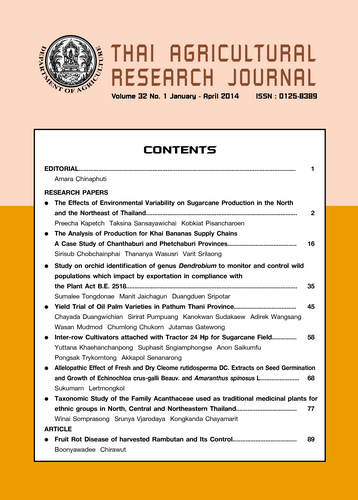Fruit Rot Disease of Harvested Rambutan and Its Control
DOI:
https://doi.org/10.14456/thaidoa-agres.2014.12Keywords:
rambutan, fruit rot disease, pathogen, controlAbstract
Fruit rot disease of rambutan caused by Lasiodiplodia theobromae,Gliocephalotrichum spp., Colletotrichum gleosporioides, Pestalotiopsis sp. and Phomopsis sp. is the major problem of rambutan which reduces both its quality and shelf life. The pathogens persist in soil and plant residues in orchard. Conidia of fungi are spreaded by wind and rain. Symptoms of fruit rot disease appear as dark brown lesions on the rind of fruit, after that the lesions enlarged and turned dark brown in colour. Greyish brown or white yellowish mycelia were observed on infection depending on type of fungi. Light brown, water-soaked areas developed initially in the pulp which enlarged later. Complete deterioration of fruits occurred after 3-5 days at room temperature. These are many methods to control fruit rot disease of rambutan such as biological, generally safe compounds, low temperature, ozone and chitosan for reducing disease severity and extending shelf life.
Downloads
Published
How to Cite
Issue
Section
License
Copyright (c) 2017 วารสารวิชาการเกษตร (Thai Agricultural Research Journal)

This work is licensed under a Creative Commons Attribution-NonCommercial-NoDerivatives 4.0 International License.
Thai Agricultural Research Journal



